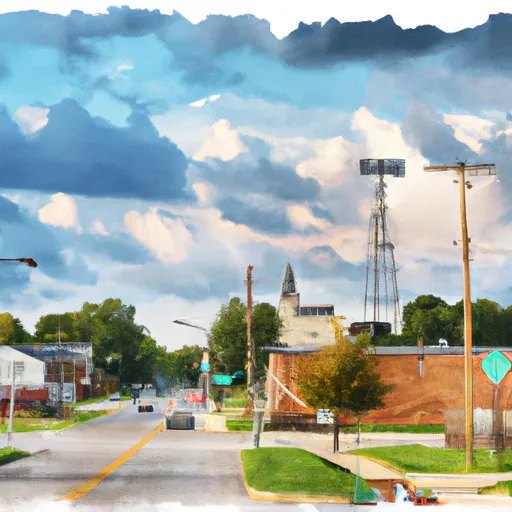-
 Snoflo Premium
Snoflo Premium
Get unlimited access to all our content
With no Ad interruptions! - Start Your Free Trial Login with existing account
Ingalls
Eden Index
Climate
8.3
•
Recreation
3.1
•
Community
2.5
•
Safeguard
5.0/10

Ingalls, Indiana is a small town located in Madison County, in the central part of the state. The climate in Ingalls is classified as humid continental, experiencing warm summers and cold winters. Average high temperatures in the summer range from the mid-80s to low 90s°F (29-34°C), while average winter highs range from the mid-30s to mid-40s°F (2-7°C). Precipitation is evenly distributed throughout the year, with July being the wettest month.
Ingalls benefits from a few hydrological constituents. The town is situated near Fall Creek, a tributary of the White River, providing a scenic natural feature. Additionally, there are several small ponds and creeks in the area, contributing to the local hydrology and potentially offering fishing opportunities.
Outdoor recreation opportunities in Ingalls include various activities. The town has a few parks where residents and visitors can enjoy picnicking, walking trails, and playgrounds. The proximity to Fall Creek and nearby reservoirs allows for fishing, kayaking, and canoeing. Additionally, there are opportunities for hiking and biking in the surrounding countryside. Ingalls provides a small-town atmosphere with access to nature for outdoor enthusiasts.
What is the Eden Index?
The Snoflo Eden Index serves as a comprehensive rating system for regions, evaluating their desirability through a holistic assessment of climate health, outdoor recreation opportunities, and natural disaster risk, acknowledging the profound impact of these factors on livability and well-being.
Climate Health Indicator (CHI): 8.3
Ingalls receives approximately
1087mm of rain per year,
with humidity levels near 83%
and air temperatures averaging around
11°C.
Ingalls has a plant hardyness factor of
6, meaning
plants and agriculture in this region thrive during a short period during spring and early summer. Most
plants will die off during the colder winter months.
By considering the ideal temperature range, reliable water supplies, clean air, and stable seasonal rain or snowpacks, the Climate Health Indicator (CHI) underscores the significance of a healthy climate as the foundation for quality living.
A healthy climate is paramount for ensuring a high quality of life and livability in a region, fostering both physical well-being and environmental harmony. This can be characterized by ideal temperatures, reliable access to water supplies, clean air, and consistent seasonal rain or snowpacks.
Weather Forecast
Streamflow Conditions
Patoka-White
Area Rivers
Patoka-White
Snowpack Depths
Patoka-White
Reservoir Storage Capacity
Patoka-White
Groundwater Levels
Recreational Opportunity Index (ROI): 3.1
The Recreational Opportunity Index (ROI) recognizes the value of outdoor recreational options, such as parks, hiking trails, camping sites, and fishing spots, while acknowledging that climate plays a pivotal role in ensuring the comfort and consistency of these experiences.
Access to outdoor recreational opportunities, encompassing activities such as parks, hiking, camping, and fishing, is crucial for overall well-being, and the climate plays a pivotal role in enabling and enhancing these experiences, ensuring that individuals can engage in nature-based activities comfortably and consistently.
Camping Areas
| Campground | Campsites | Reservations | Toilets | Showers | Elevation |
|---|---|---|---|---|---|
| Deam Lake State Rec Area | 185 | 533 ft | |||
| Salt River Rec Area | None | 428 ft | |||
| Irwin City Park | 12 | 662 ft | |||
| Charlestown State Park | 190 | 616 ft | |||
| Clark State Forest | 45 | 851 ft | |||
| Muscatatuck | 35 | 718 ft | |||
| South Harrison Co Park | None | 754 ft | |||
| Heflen Co Park | None | 639 ft | |||
| Hardy Lake State Rec Area | 170 | 650 ft | |||
| White River Campground | 106 | 774 ft |
Nearby Ski Areas
Catastrophe Safeguard Index (CSI):
The Catastrophe Safeguard Index (CSI) recognizes that natural disaster risk, encompassing floods, fires, hurricanes, and tornadoes, can drastically affect safety and the overall appeal of an area.
The level of natural disaster risk in a region significantly affects safety and the overall livability, with climate change amplifying these risks by potentially increasing the frequency and intensity of events like floods, fires, hurricanes, and tornadoes, thereby posing substantial challenges to community resilience and well-being.
Community Resilience Indicator (CRI): 2.5
The Community Resilience Indicator (CRI) recognizes that education, healthcare, and socioeconomics are crucial to the well-being of a region. The CRI acknowledges the profound impact of these elements on residents' overall quality of life. By evaluating educational resources, healthcare accessibility, and economic inclusivity, the index captures the essential aspects that contribute to a thriving community, fostering resident satisfaction, equity, and social cohesion.

